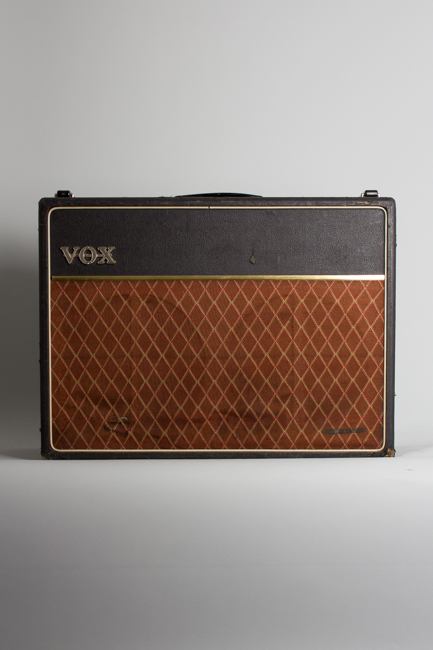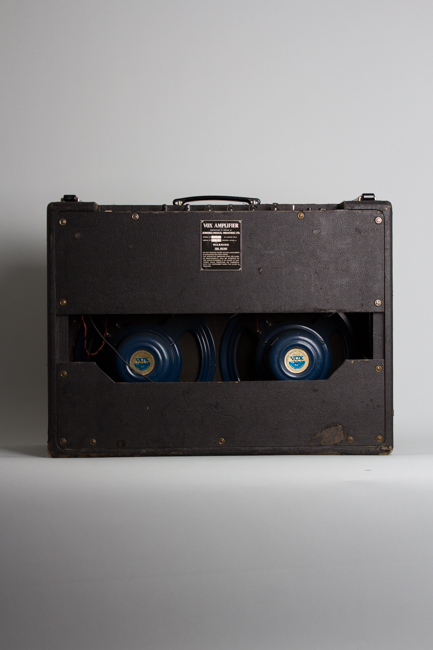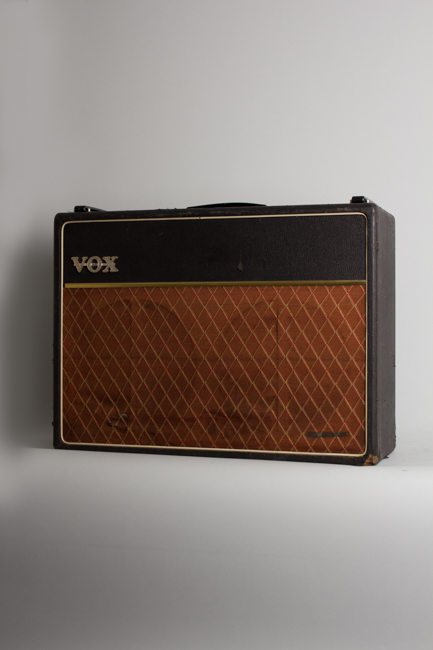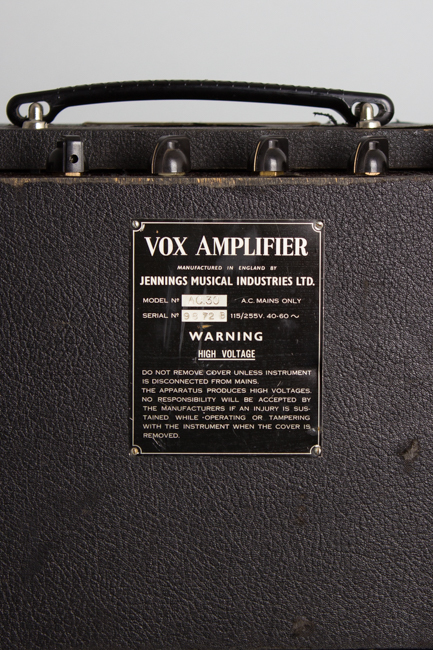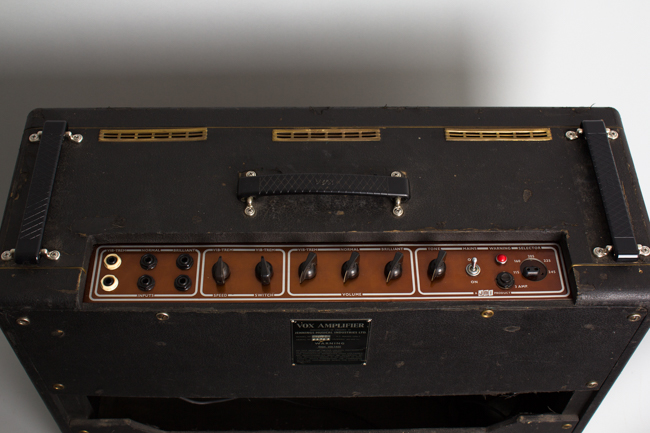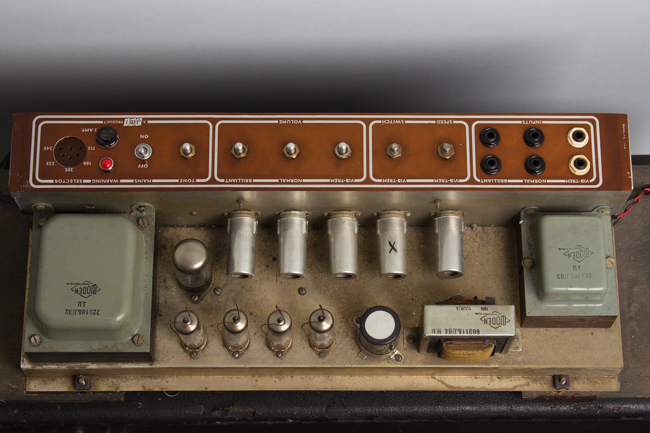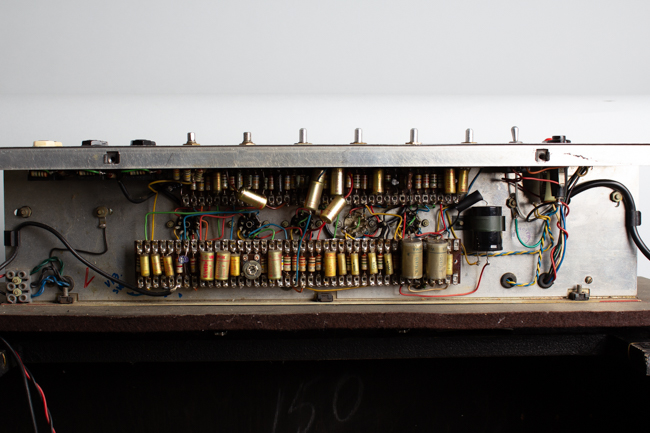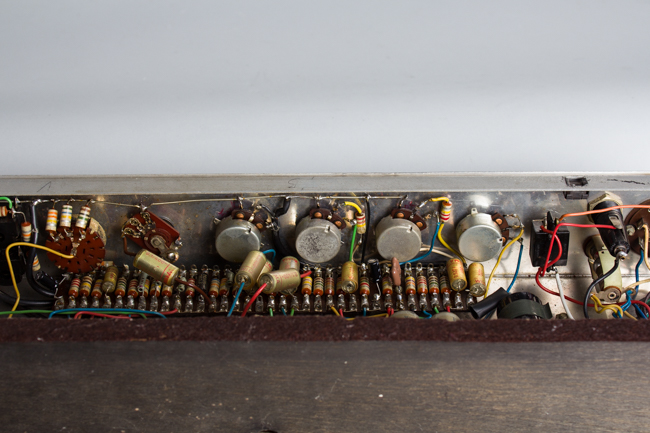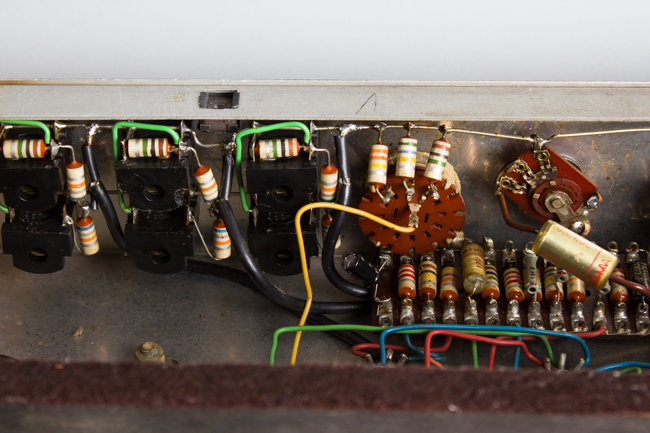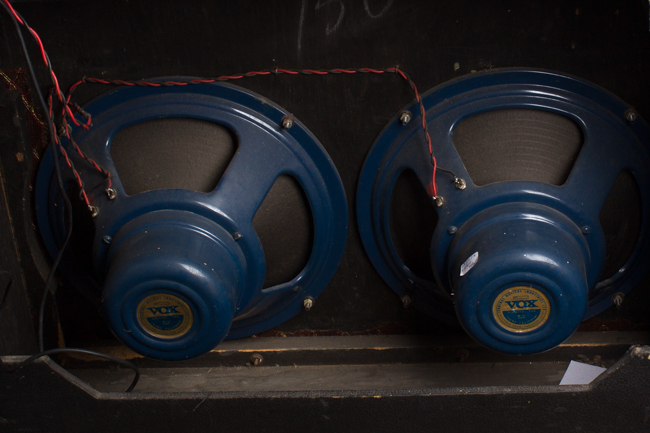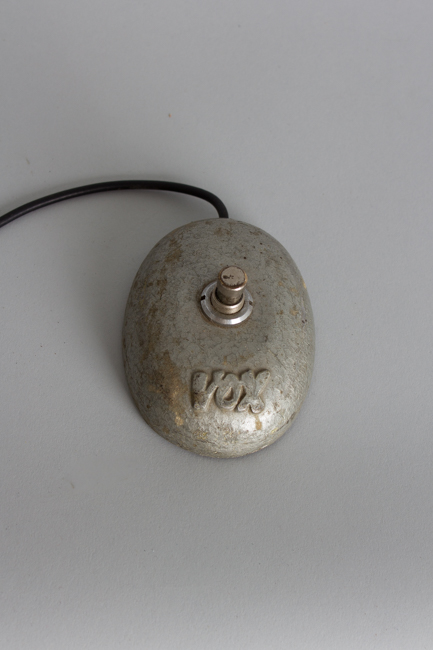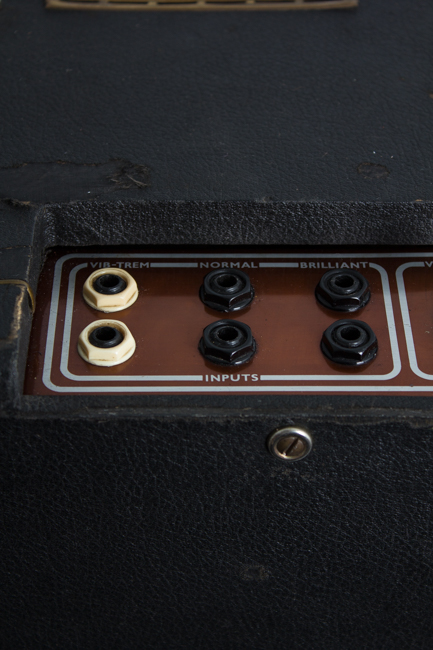Vox AC-30/6 Twin Tube Amplifier (1963)
This item has been sold.
Item # 10739
Prices subject to change without notice.
Vox AC-30/6 Twin Model Tube Amplifier (1963), made in Dartford, Kent, England, serial # 9872-B, black tolex covering finish.
One of the most revered of all amplifiers, the Vox AC-30 was literally THE sound of the UK Beat Era and the US British Invasion and is still one of the most popular amps in the world for those who prize pure tone above all. JMI (Jennings Musical Industries) of Dartford, Kent could hardly keep up with the demand as the Beat Boom took England by storm; players of the time used a number of now-classic guitars but nearly all owned -- or coveted -- an AC-30. Bill Wyman brought an AC-30 to his audition for the Rolling Stones and instantly got the gig for just owning one!
The AC-30 Twin was conceived both as a response to the Fender Twin and demands by top JMI/Vox endorsers the Shadows for a louder, more reliable stage amp. It was a complete overhaul of its single-speaker predecessor, overcoming a major problem all amp manufacturers have had to contend with; no single speaker made at the time that could handle the output of increasingly higher-powered amps. Speakers rated for sometimes half the power output of a circuit would be used, often blowing as a result of being run constantly at top volume by top touring musicians, especially The Shadows and prime Vox testers Peter Jay & the Jaywalkers.
The twin overhaul also featured a completely redesigned chassis, abandoning the old top-and-bottom format that had been proven fairy detrimental to the longevity of the amplifiers; touring musicians habitually threw cables and such in the back of the amp where the fragile tubes were mounted upright. The new version was part-aluminum, part-steel construction, containing everything including the tubes at the top of the cabinet much like Fender amps of the day. Unlike Fender practice these were mounted front-ward in the chassis necessitating accompanying vents at the top-front of the cabinet.
The AC-30 Twin was based on the earlier AC-15 with twice as many EL84 power tubes and doubling up the speakers, with a couple other changes to accommodate the higher power rating. These were notably a GZ34 rectifier tube and overall higher voltages to give the AC-30 more headroom. As groups in the UK moved into bigger venues this became crucial; the desire for a heavily overdriven guitar sound was still a few years away!
By Spring of 1963, the AC-30 Twin featured same split-front styling as the rest of the Vox line-up of the day, covered in "pebble" black covering with brown-backed diamond grille cloth. Three handles were fitted at the top alongside three brass louvers for the aforementioned vents. Anyone who has carried an AC-30 up (or down) narrow club stairs appreciates the extra end handles! According to Jim Eleya's exhaustive research, this particular amp is "version 10" which was made between May/June and December of 1963; the serial number suggests this was a late example built right at the end of that period.
This is the AC-30/6 version of the Twin model, featuring Dick Denny's brainchild 6-input/3-channel design; one channel labeled normal, one brilliant and one vib/trem. The additional channel was made possible by going from EF86 pentodes to the dual-triode 12AX7, allowing for two gain-stages per tube, as opposed to one. The 12AX7 was comparatively a far less problematic tube in terms of noise and reliability, though arguably considered less Hi-Fi with a narrower frequency range. This version of the AC-30/6 was in production beginning in late 1961 and is the first to feature the trademark copper anodized escutcheon panel. Running four EL84 power tubes into two Oyster T.530 speakers, this AC-30 puts out around 30 watts, true to its name.
Many AC-30s from the early-mid 1960s have generations of heavy use behind them, and the wear to prove it. This one survived the Beat Boom and beyond showing wear to the cabinet and some lost external hardware but internally completely intact and well preserved. Unsurprisingly it is a truly fantastic sounding amp, especially if you have opportunity to crank it up!
Height is 20 1/2 in. (52.1 cm.), 27 1/4 in. (69.2 cm.) width, and 10 1/4 in. (26 cm.) deep.
This AC-30 is a fairly well-preserved example as they go, with a modicum of overall external wear but largely true to its original state. It is quite rare to find one of these amps in much better condition; most belonged to pro players gigging them into the ground decades ago and the thin pebble black covering is easily damage. This one shows a fair amount scuffing and moderate wear, with small patches of missing covering especially on the top and corners and edges. These spots have been retouched thoughtfully and tinted black to preserve overall appearance and covering was reattached where possible. This amp pre-dates the familiar plastic end caps, but it looks like something now lost was pinned to each upper corner, leaving tiny pinholes behind.
The serial number plate on the back has some scratches and scrapes but is not bad overall. The copper top panel is nicely clean with minimal disturbance. New repro handles have been fitted in the outer positions and a NOS vintage handle for the center placement. The grille cloth shows a tear in the lower left corner that appears to have been very neatly patched with matching material. The lower right corner badge that would have said 'Thirty' is unfortunately long gone. The original footswitch, however, is still present with the amp.
Internally, the AC-30 remains original and largely untouched except for the bare minimum component replacements needed to keep it working to modern standards. The power, choke and output transformers are all original and made by Woden, marked #72318 J/82, #66311 J/84 and #66310 J/83, respectively. The two blue 'Oyster' T.530 speakers are original including the cones. The amp has received our typical service/maintenance including replacement of electrolytic caps, cleaning of all jacks, pots and sockets and a new grounded 3-prong power cord installed. This amp was made at the apex of the UK Beat Boom, just before Beatlemania spread to America. We don't know who may have played it in 1964 (and since!) but it oozes vibe and is simply one of the coolest AC-30s we have had, a Beat-era masterpiece and a spectacular sounding amp by any standard. Very Good + Condition.
One of the most revered of all amplifiers, the Vox AC-30 was literally THE sound of the UK Beat Era and the US British Invasion and is still one of the most popular amps in the world for those who prize pure tone above all. JMI (Jennings Musical Industries) of Dartford, Kent could hardly keep up with the demand as the Beat Boom took England by storm; players of the time used a number of now-classic guitars but nearly all owned -- or coveted -- an AC-30. Bill Wyman brought an AC-30 to his audition for the Rolling Stones and instantly got the gig for just owning one!
The AC-30 Twin was conceived both as a response to the Fender Twin and demands by top JMI/Vox endorsers the Shadows for a louder, more reliable stage amp. It was a complete overhaul of its single-speaker predecessor, overcoming a major problem all amp manufacturers have had to contend with; no single speaker made at the time that could handle the output of increasingly higher-powered amps. Speakers rated for sometimes half the power output of a circuit would be used, often blowing as a result of being run constantly at top volume by top touring musicians, especially The Shadows and prime Vox testers Peter Jay & the Jaywalkers.
The twin overhaul also featured a completely redesigned chassis, abandoning the old top-and-bottom format that had been proven fairy detrimental to the longevity of the amplifiers; touring musicians habitually threw cables and such in the back of the amp where the fragile tubes were mounted upright. The new version was part-aluminum, part-steel construction, containing everything including the tubes at the top of the cabinet much like Fender amps of the day. Unlike Fender practice these were mounted front-ward in the chassis necessitating accompanying vents at the top-front of the cabinet.
The AC-30 Twin was based on the earlier AC-15 with twice as many EL84 power tubes and doubling up the speakers, with a couple other changes to accommodate the higher power rating. These were notably a GZ34 rectifier tube and overall higher voltages to give the AC-30 more headroom. As groups in the UK moved into bigger venues this became crucial; the desire for a heavily overdriven guitar sound was still a few years away!
By Spring of 1963, the AC-30 Twin featured same split-front styling as the rest of the Vox line-up of the day, covered in "pebble" black covering with brown-backed diamond grille cloth. Three handles were fitted at the top alongside three brass louvers for the aforementioned vents. Anyone who has carried an AC-30 up (or down) narrow club stairs appreciates the extra end handles! According to Jim Eleya's exhaustive research, this particular amp is "version 10" which was made between May/June and December of 1963; the serial number suggests this was a late example built right at the end of that period.
This is the AC-30/6 version of the Twin model, featuring Dick Denny's brainchild 6-input/3-channel design; one channel labeled normal, one brilliant and one vib/trem. The additional channel was made possible by going from EF86 pentodes to the dual-triode 12AX7, allowing for two gain-stages per tube, as opposed to one. The 12AX7 was comparatively a far less problematic tube in terms of noise and reliability, though arguably considered less Hi-Fi with a narrower frequency range. This version of the AC-30/6 was in production beginning in late 1961 and is the first to feature the trademark copper anodized escutcheon panel. Running four EL84 power tubes into two Oyster T.530 speakers, this AC-30 puts out around 30 watts, true to its name.
Many AC-30s from the early-mid 1960s have generations of heavy use behind them, and the wear to prove it. This one survived the Beat Boom and beyond showing wear to the cabinet and some lost external hardware but internally completely intact and well preserved. Unsurprisingly it is a truly fantastic sounding amp, especially if you have opportunity to crank it up!
Height is 20 1/2 in. (52.1 cm.), 27 1/4 in. (69.2 cm.) width, and 10 1/4 in. (26 cm.) deep.
This AC-30 is a fairly well-preserved example as they go, with a modicum of overall external wear but largely true to its original state. It is quite rare to find one of these amps in much better condition; most belonged to pro players gigging them into the ground decades ago and the thin pebble black covering is easily damage. This one shows a fair amount scuffing and moderate wear, with small patches of missing covering especially on the top and corners and edges. These spots have been retouched thoughtfully and tinted black to preserve overall appearance and covering was reattached where possible. This amp pre-dates the familiar plastic end caps, but it looks like something now lost was pinned to each upper corner, leaving tiny pinholes behind.
The serial number plate on the back has some scratches and scrapes but is not bad overall. The copper top panel is nicely clean with minimal disturbance. New repro handles have been fitted in the outer positions and a NOS vintage handle for the center placement. The grille cloth shows a tear in the lower left corner that appears to have been very neatly patched with matching material. The lower right corner badge that would have said 'Thirty' is unfortunately long gone. The original footswitch, however, is still present with the amp.
Internally, the AC-30 remains original and largely untouched except for the bare minimum component replacements needed to keep it working to modern standards. The power, choke and output transformers are all original and made by Woden, marked #72318 J/82, #66311 J/84 and #66310 J/83, respectively. The two blue 'Oyster' T.530 speakers are original including the cones. The amp has received our typical service/maintenance including replacement of electrolytic caps, cleaning of all jacks, pots and sockets and a new grounded 3-prong power cord installed. This amp was made at the apex of the UK Beat Boom, just before Beatlemania spread to America. We don't know who may have played it in 1964 (and since!) but it oozes vibe and is simply one of the coolest AC-30s we have had, a Beat-era masterpiece and a spectacular sounding amp by any standard. Very Good + Condition.
